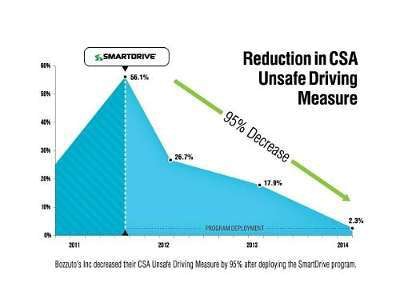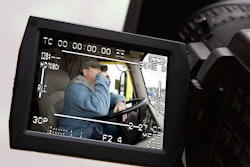At the ALK Transportation Technology Summit this week, manufacturers of video systems were prevalent among the various and sundry business and safety technology presentations. Fleets are adopting the systems for several reasons, chief among them what they see as the driver-improvement and -exoneration aspects they bring to management’s relationship with their on-highway captains.
 Angie Buchanan, Melton Safety and HR Vice President
Angie Buchanan, Melton Safety and HR Vice PresidentAngie Buchanan of Melton Truck Lines spoke about the flatbed fleet’s adoption of the road- and driver-facing camera technology of Lytx, maker of the DriveCam system. “Eight-one percent of all car-truck collisions are caused by the car driver,” she noted, while the truck driver is often blamed. The DriveCam system gives the fleet, she said, a powerful tool to exonerate the driver when warranted — the vast majority of cases.
 Food and retail-products wholesaler and distributor Bozzuto’s Inc., based in Connecticut, installed the SmartDrive camera system in the fleet in mid-2011, utilizing the cameras in hopes of correcting driver errors that lead to moving violations and a negative effect on the Unsafe Driving BASIC score under the Compliance, Safety, Accountability safety-ranking program. Over the near three years since implementation, the company Unsafe Driving ranking has fallen by close to 100 percent to among the best such scores in its peer group.
Food and retail-products wholesaler and distributor Bozzuto’s Inc., based in Connecticut, installed the SmartDrive camera system in the fleet in mid-2011, utilizing the cameras in hopes of correcting driver errors that lead to moving violations and a negative effect on the Unsafe Driving BASIC score under the Compliance, Safety, Accountability safety-ranking program. Over the near three years since implementation, the company Unsafe Driving ranking has fallen by close to 100 percent to among the best such scores in its peer group.James Berry of Bulkmatic’s Southeast region, speaking to the fleet representatives in the audience, noted a recent accident the company was involved in that included a fatality – “We’ve already exonerated that driver,” he said, utilizing video captured by the SmartDrive SR3 cameras his company has installed. Following accidents in the past, how many fleets in the audience, he wondered, had asked, “What if we had just had a camera in that truck?”

While the existence of a video record of an accident was termed a “double-edged sword” aspect of use of the devices by many, some viewed it as a plus even in cases where the truck driver is demonstrably at fault. The video record heads off expensive attorney’s fees spent in fighting a losing battle in court.
Drivers are using such systems manually themselves for other reasons, chief among them at Bulkmatic, said Berry, to head off an irresponsible four-wheeler’s call-in complaint: “The biggest manual activation” of the SmartDrive cameras there, which when activated capture 20 seconds’ worth of video for saving partially before and after the point of activation, is a four-wheeler cutting off a driver, “maybe a rude gesture is involved, and ‘they could have called in on me, so I just hit that clip,'” Berry noted, paraphrasing a driver.
Mitigating driving distractions and in-cab behaviors that go against company policy, too, are among some fleet worries. Both DriveCam and SmartDrive employ staff tasked with filtering which video clips are sent to fleet personnel to review based a set of criteria set by the fleet. Most often triggered by g-force events (such as hard braking, evasive maneuvers or collisions), the camera clips may also capture drivers utilizing cell phones, smoking or doing something else in-cab that contradicts company policy.
United Natural Foods Inc. (UNFI) Regional Fleet Safety Manager Deb Dancause, for instance, noted the company’s no-smoking policy in its trucks. “We are able to pick what we want to see,” she said, to “focus on the items important to us.” Drivers seen smoking in clips triggered by other events would see those clips sent to UNFI.
Encroachments on the measure of freedom traditionally offered by the business of truck driving are chief among some drivers’ objections to the devices, chronicled in past Overdrive coverage. Buchanan noted that acceptance was not without its challenges when Melton made the choice to implement three years ago, though only two drivers have left “in the last three years due to the camera,” she said. The benefits, she added, have outweighed the negatives.
“Without [a camera system] you probably don’t know what’s going on in your truck,” she said. “You see unauthorized passengers, unauthorized drivers….” The list went on. Buchanan, however, emphasized careful consideration of follow-on actions. “You have two choices: you can automatically terminate” or, secondly, “you can retrain and reevaluate and offer second chances with accountability.”
Going the latter route is the better goal, said Berry: “We’re not doing it for discipline – it’s to coach, not to fire. We believe this program has that potential.”
“Cameras help us measure ourselves in unique ways,” said Buchanan, as well as “enable us to identify good performance and celebrate that.”
With confidence in the training power of the systems, Melton, said Buchanan, is among fleets that have changed experience requirements to hire on with the fleet as a result. To date, “we’ve hired 200 less experienced drivers,” she added.
Do you or your fleet utilize a dashcam or other camera in or on your truck? Tell us in this linked poll, and weigh in on the devices in the comments.












